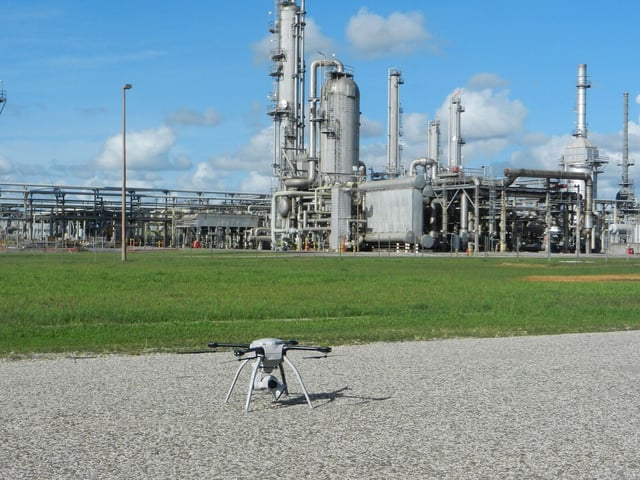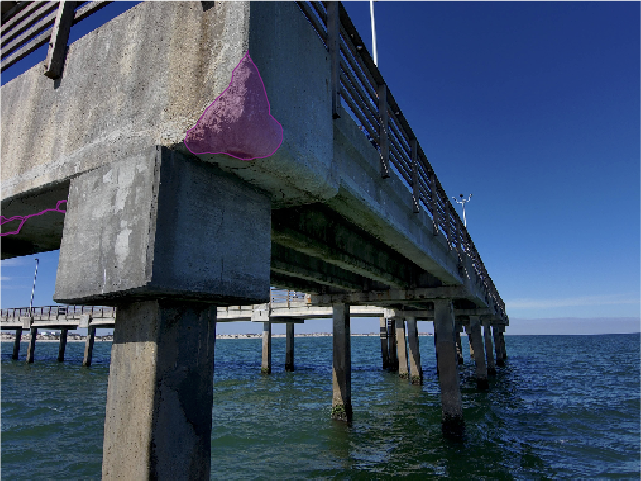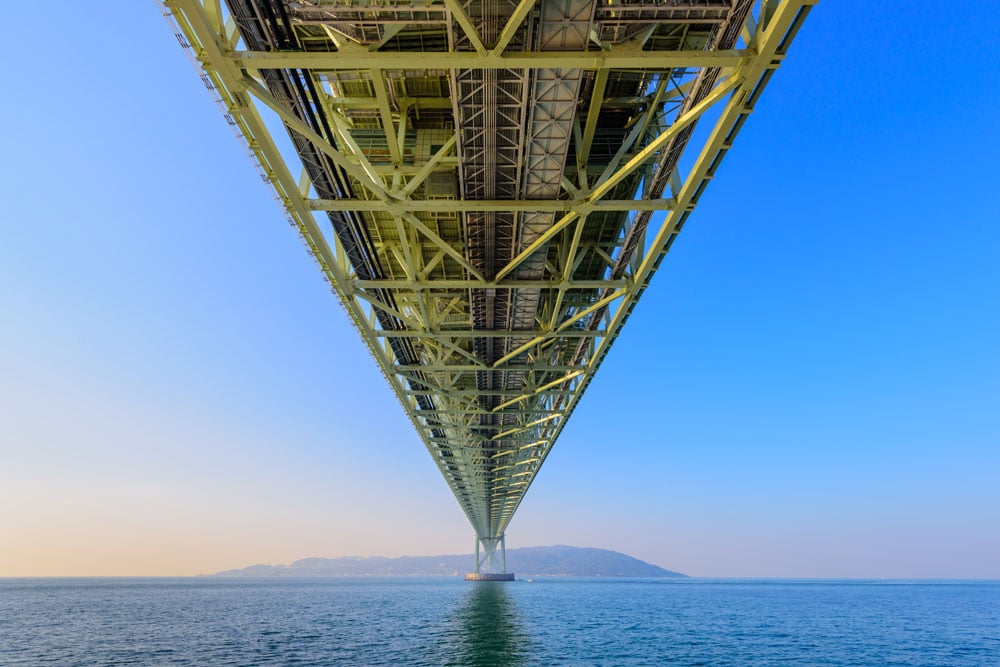Regular inspection and preventative maintenance of oil, gas and other energy or petrochemical -related infrastructure such as gas tanks, pipelines and smoke stacks; is necessary to minimize corporate liability, ensure safety of staff and the public, protect the environment, and maximize profits. However, managing these infrastructures incurs both cost and risk.
Why utilize UAV inspection?
Inspecting any type of structure requires the expertise of skilled inspection personnel. For these members of the team to be able to undertake their work, visual inspection typically needs to take place in-situ, by climbing or walking on the structure in question. This very activity means that to keep a facility safe, team members need to be put into harm’s way.
For example:
- Gas storage tank roofs need to be inspected for corrosion; how can an inspection engineer assess whether corrosion has already taken place on a tank roof, before they step upon it?
- Accessing a smoke stack will require rope access, but can inspection personnel be sure that fall-arrest equipment such as hand railings or rope clasps are in a safe condition to be used? Aside from the risk of fall, a live flare smokestack will need to be shut down to conduct a in-situ safe inspection through traditional means; leading to significant economic losses (typically over $1million USD per day[1]) on behalf of the plant operator.
To increase the efficiency of inspection processes, facility managers are increasingly looking towards drone services in aerial inspection to reduce risk in visual inspection procedures.
Requirements for intrinsic safety on oil, gas and petrochemical plants
By their nature, petrochemical and energy-generation plants are areas where dangerous concentrations of flammable materials will be present. Not only can there be flammable gases present, hot surfaces and dust also bring risk of ignition[2]. With this brings a requirement to employ intrinsic safety, which can be described as the protection techniques employed when operating any type of electrical equipment, that limits any electrical or thermal energy that is available for ignition3. Electrical equipment that utilizes motor brushes and connectors brings risk of generating small internal electrical arcs[3]. Like other types of survey and inspection instruments that are increasingly being operated on energy and petrochemical plants; the drone platform itself is not typically 100% intrinsic safe and therefore needs to also be assumed to bring risk in its operation.
Intrinsic safety is about minimizing risk of ignition. Following a procedures and processes perspective to understanding both the characteristics of the UAV, the criteria for safe operation and the requirements of the facility, will therefore lead to safe operation of the UAV platform over these hazardous sites for either NDI or Preventatice Maintanance.

Minimizing risk in UAV inspection
In the UAV industry, there is still discussion and developments among the manufacturers to define what can universally be understood to be an intrinsically safe drone platform. UAVs have however been successfully been deployed to inspect hazardous energy and petrochemical sites, worldwide, for over the past 5 years. The specific health and safety plan for every facility where an inspection project takes place will be different from facility to facility; but there are set of guiding principles that successfully reduce the risk of professional UAV inspection operations to acceptable levels.
Choice of platform
Most professional UAV platforms now utilize brushless, magnetic motors that dramatically reduce risk of ignition from friction. While some long-range and heavy-lift UAVs are powered by liquid fuel, any UAV platform used for inspection purposes over hazardous sites will utilize sealed batteries.
Important when flying over sites such as live flare stacks is that the risk of spark on battery connectors, or of UAV mounted components (such as external batteries and sensor payloads) falling, is minimized. UAV platforms that incorporate internal batteries that are incorporated inside the UAV’s body, together with sensor payloads that are mechanically integrated into that UAV, should therefore be the type that are deployed on these types of projects.
Additional thermal or gas sensors
Professional-grade inspection cameras for aerial imaging now often incorporate both thermal and visual sensors. Even if it is only visual photographic data that is being captured for an inspection project, the real-time feedback from the thermal sensors can provide a warning of extreme conditions onsite throughout the survey. When inspecting cold venting smoke stacks where unignited hydrocarbons can be present; methane or various other gas sensors
Flight planning
The best way to mitigate risk when undertaking inspection over flammable and hazardous sites, is through comprehensive planning. The reason that drone inspection is used at all, is because it enables visual and non-destructive inspection of a site to be undertaken from a distance, and without inspection personnel needing to be on the structure itself.
With increase in distance, also comes decrease in risk; as does the concept of exclusion zones come into factors that dictate intrinsically safe procedures2. Pre-planned flight paths can easily keep a drone a typical 20-50 feet from a structure, high resolution imaging can easily be captured 300 feet away; the exact distance will always be defined in discussion between the UAV inspection service provider and the facilities manager at the plant. Common-sense also dictates that flat plans keep the UAV at an angular tangent away from the structure, rather than directly overhead should anything fall.
Deploying UAVs to inspect highly flammable sites
All operations around oil and gas -related infrastructure need to be carefully regulated and tightly controlled. Policies such as those related to intrinsic safety have long been in place to protect both people and the environment on these types of sites. While intrinsic safety describes a set of electrical design principles, it also considers deployment procedures too.
UAV platforms are not fully intrinsically safe in their electrical design. However, professional UAV inspection operations have proven to offer an inspection procedure that minimizes health and safety risk to both plant staff and the public; in addition to bringing significant economic savings to the plant through not needing to entirely shut down production.
Central to obtaining these benefits from drone inspection is utilizing professional UAV equipment and flight procedures. If deployed correctly, both the time that site inspection personnel spend with their feet on the ground, and a facility’s economic savings, will be maximized.
[1] https://www.aeryon.com/casestudies/flare-stack-inspection-at-50-90-lower-cost-with-aeryon-suas-solutions
[2] http://www.omega.ca/technical-learning/understanding-what-is-meant-by-intrinsically-safe.html
[3] www.wikipedia.org/wiki/Intrinsic_safety
[4] http://www.engineerlive.com/content/drones-cut-risk-industrial-inspections
-543342-edited.jpg?width=640&name=isw%204%20by%20Ian%20Hannah%20(2)-543342-edited.jpg)






